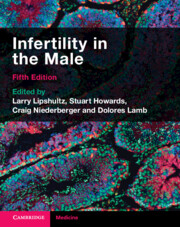Book contents
- Infertility in the Male
- Infertility in the Male
- Copyright page
- Contents
- Contributors
- Foreword
- Abbreviations
- Introduction
- Section 1 Scientific Foundations of Male Infertility
- Chapter 1 Anatomy and Embryology of the Male Reproductive Tract and Gonadal Development, the Epididymis, and Accessory Sex Organs
- Chapter 2 Cellular Architecture and Function of the Testis
- Chapter 3 Maturation and Function of Sperm
- Chapter 4 The Male Reproductive Endocrine System
- Chapter 5 Erection, Emission, and Ejaculation
- Chapter 6 Genomics, Epigenetics, and Male Reproduction
- Section 2 Clinical Evaluation of the Infertile Male
- Section 3 Laboratory Diagnosis of Male Infertility
- Section 4 Treatment of Male Infertility
- Section 5 Health Care Systems and Culture
- Index
- References
Chapter 2 - Cellular Architecture and Function of the Testis
from Section 1 - Scientific Foundations of Male Infertility
Published online by Cambridge University Press: 08 July 2023
- Infertility in the Male
- Infertility in the Male
- Copyright page
- Contents
- Contributors
- Foreword
- Abbreviations
- Introduction
- Section 1 Scientific Foundations of Male Infertility
- Chapter 1 Anatomy and Embryology of the Male Reproductive Tract and Gonadal Development, the Epididymis, and Accessory Sex Organs
- Chapter 2 Cellular Architecture and Function of the Testis
- Chapter 3 Maturation and Function of Sperm
- Chapter 4 The Male Reproductive Endocrine System
- Chapter 5 Erection, Emission, and Ejaculation
- Chapter 6 Genomics, Epigenetics, and Male Reproduction
- Section 2 Clinical Evaluation of the Infertile Male
- Section 3 Laboratory Diagnosis of Male Infertility
- Section 4 Treatment of Male Infertility
- Section 5 Health Care Systems and Culture
- Index
- References
Summary
The cellular architecture of the mammalian testis that supports testis function, which, in turn, maintains spermatogenesis throughout adulthood to produce millions of sperm on a daily basis from rodents to humans, has been eminently reviewed by investigators in recent years, based on morphological, biochemical, and molecular studies [1–10]. As such, in order to avoid a repetitive account on this topic, compared with earlier reviews, we attempt to provide insightful information on this topic based on recent studies which have not been evaluated in details, as noted in the following sections. Thus, this avoids redundancy because readers can refer to the earlier reviews pertinent to the cellular architecture of the testis that supports spermatogenesis as reviewed in [1–10]. It is conceivable that some necessary discussion still overlap with earlier reviews or earlier editions of this reference work. This is done such that readers can follow through the discussion here without the necessity of going through other contents to grasp related facts and concepts. Nonetheless, we will refer to other reviews for additional discussion on specific topics in this chapter when a detailed and redundant description is not warranted.
- Type
- Chapter
- Information
- Infertility in the Male , pp. 17 - 38Publisher: Cambridge University PressPrint publication year: 2023



